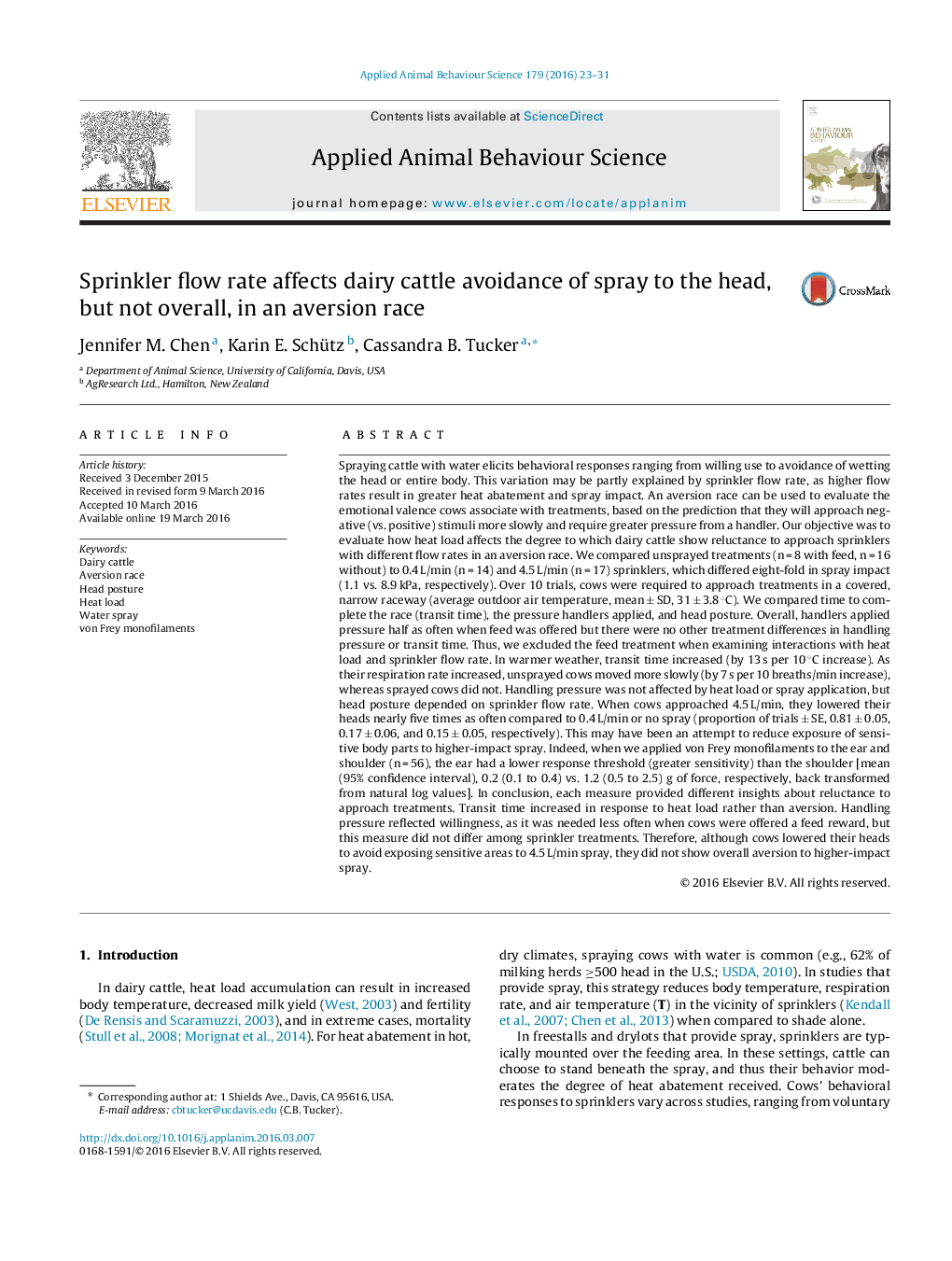| کد مقاله | کد نشریه | سال انتشار | مقاله انگلیسی | نسخه تمام متن |
|---|---|---|---|---|
| 4522368 | 1625327 | 2016 | 9 صفحه PDF | دانلود رایگان |
• When no spray was offered, cows moved more slowly as respiration rate increased.
• Cows did not show this heat related slowing when offered 0.4 or 4.5 L/min spray.
• 4.5 L/min resulted in more head lowering compared to 0.4 L/min or no spray.
• This head posture may be an attempt to protect sensitive areas from spray impact.
• The ear had greater sensitivity to mechanical stimulation than the shoulder.
Spraying cattle with water elicits behavioral responses ranging from willing use to avoidance of wetting the head or entire body. This variation may be partly explained by sprinkler flow rate, as higher flow rates result in greater heat abatement and spray impact. An aversion race can be used to evaluate the emotional valence cows associate with treatments, based on the prediction that they will approach negative (vs. positive) stimuli more slowly and require greater pressure from a handler. Our objective was to evaluate how heat load affects the degree to which dairy cattle show reluctance to approach sprinklers with different flow rates in an aversion race. We compared unsprayed treatments (n = 8 with feed, n = 16 without) to 0.4 L/min (n = 14) and 4.5 L/min (n = 17) sprinklers, which differed eight-fold in spray impact (1.1 vs. 8.9 kPa, respectively). Over 10 trials, cows were required to approach treatments in a covered, narrow raceway (average outdoor air temperature, mean ± SD, 31 ± 3.8 °C). We compared time to complete the race (transit time), the pressure handlers applied, and head posture. Overall, handlers applied pressure half as often when feed was offered but there were no other treatment differences in handling pressure or transit time. Thus, we excluded the feed treatment when examining interactions with heat load and sprinkler flow rate. In warmer weather, transit time increased (by 13 s per 10 °C increase). As their respiration rate increased, unsprayed cows moved more slowly (by 7 s per 10 breaths/min increase), whereas sprayed cows did not. Handling pressure was not affected by heat load or spray application, but head posture depended on sprinkler flow rate. When cows approached 4.5 L/min, they lowered their heads nearly five times as often compared to 0.4 L/min or no spray (proportion of trials ± SE, 0.81 ± 0.05, 0.17 ± 0.06, and 0.15 ± 0.05, respectively). This may have been an attempt to reduce exposure of sensitive body parts to higher-impact spray. Indeed, when we applied von Frey monofilaments to the ear and shoulder (n = 56), the ear had a lower response threshold (greater sensitivity) than the shoulder [mean (95% confidence interval), 0.2 (0.1 to 0.4) vs. 1.2 (0.5 to 2.5) g of force, respectively, back transformed from natural log values]. In conclusion, each measure provided different insights about reluctance to approach treatments. Transit time increased in response to heat load rather than aversion. Handling pressure reflected willingness, as it was needed less often when cows were offered a feed reward, but this measure did not differ among sprinkler treatments. Therefore, although cows lowered their heads to avoid exposing sensitive areas to 4.5 L/min spray, they did not show overall aversion to higher-impact spray.
Journal: Applied Animal Behaviour Science - Volume 179, June 2016, Pages 23–31
